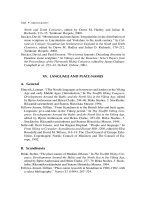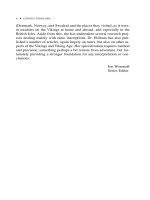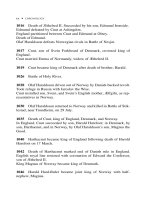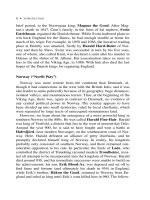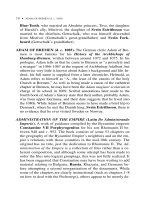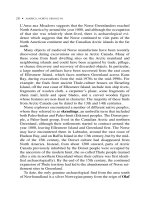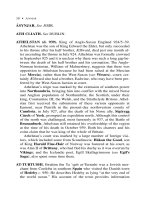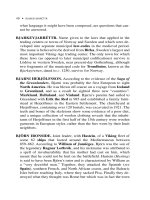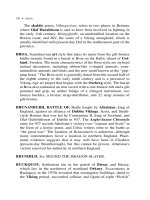The A to Z of the Vikings 12 pptx
Bạn đang xem bản rút gọn của tài liệu. Xem và tải ngay bản đầy đủ của tài liệu tại đây (68.91 KB, 10 trang )
and, following his death, Cnut I the Great in 1017. She had five chil-
dren, three by Æthelred and two by Cnut, and two of these (Harthac-
nut and Edward I the Confessor) became kings of England. During
Cnut’s reign, Emma seems to have enjoyed considerable status and
power, appearing frequently in charter witness-lists, and she is fa-
mously depicted alongside Cnut, presenting a gold cross to the New
Minster in Winchester, in the Liber Vitae (New Minster Register,
British Library, MS Stowe 944 f6r). However, after Cnut’s death and
during the brief rule of Harold Harefoot, Emma was driven into ex-
ile in Flanders, under the protection of Count Baldwin. Harold’s death
in 1040 saw her return to England with her son, Harthacnut, now king
of England, and for two years she enjoyed a similar degree of power
and public prominence as she had under Cnut’s rule. During this pe-
riod she commissioned the Encomium Emmae Reginae, and an im-
age in the only extant manuscript of this text shows her enthroned,
receiving this work, with her sons Harthacnut and Edward I looking
on. Despite the accession of another of her sons (Edward I the Con-
fessor), upon Harthacnut’s death in 1042, Emma’s political career was
at an end—Edward deprived her of her lands and treasure and she
lived out her life in relative obscurity in Winchester. She was buried
alongside Cnut, in the Old Minster, in Winchester.
EMUND. King of the Svear (see Svealand) in the second half of the
11th century. Emund was the son of Olof Skötkonung by a “concu-
bine” according to Adam of Bremen and was the half brother of
Anund Jakob, who he succeeded around the year 1050. Adam’s at-
titude to Emund is hostile, describing him as “the Bad” (although
sometimes also as “Gamular,” meaning “the Old”). The reason for
this probably lies in both Emund’s birth and in his appointment of a
bishop, Osmund, “of irregular status,” a “vagabond” who did not rec-
ognize the primacy of the mission of Hamburg-Bremen. According to
Adam, Emund was succeed by his nephew Stenkil.
ENCOMIUM EMMAE REGINAE. Work commissioned by Emma of
Normandy in 1041–1042 after the death of her second husband,
Cnut I the Great, and while her son, Harthacnut, was ruling as king
of England. It survives in one mid-11th-century Latin manuscript
(BL Additional 33241), written by two scribes, in which she is de-
88 • EMUND
picted enthroned with Harthacnut and Edward I standing beside her.
Encomium Emmae Reginae was written by a monk in the monastery
of St-Bertin (St-Omer), Flanders, as a history of Cnut’s reign and his
achievements, and is therefore also known as Gesta Cnutonis Regis
“The Deeds of King Cnut.” Encomium Emmae Reginae also de-
scribes Cnut and Emma’s son, Harthacnut. Her earlier marriage to
Æthelred II is not mentioned, nor are Emma’s sons by Æthelred II,
Alfred and Edward I the Confessor. Instead, the author (often called
the Encomiast) focuses on the Scandinavian conquest of England in
1013–1016 by Svein Forkbeard and Cnut, on Cnut’s reign, and on
events following his death. In particular, the Encomiast is careful to
clear Emma from any suspicion concerning the blinding of her son,
the atheling (or prince) Alfred in 1036, and to place the blame on
Harold Harefoot.
ENGLAND. See EAST ANGLIA; MERCIA; NORTHUMBRIA;
WESSEX.
ERIK BLOOD-AX (c. 895/910–954) (ON Eiríkr bló
ðð
öx). Erik was
one of Harald Fine-Hair’s sons by his Danish queen, Ragnhild, and
killed several of his brothers in his attempt to be recognized as sole
king of Norway, hence the nickname “Blood-Ax.” He ruled as king
of Norway between c. 933–935, until he was deposed by his half
brother, Hákon the Good, and driven into exile in England. He then
briefly ruled as king of York from 947–948, until King Eadred of
England (946–955) ended Erik’s control of the Northumbrian (see
Northumbria) capital. Following Erik’s defeat, Olaf Cúarán of
Dublin established himself as king of York, until Erik was able to
reassert his control of the city in 952. He was killed shortly after-
ward, on Stainmore in North Yorkshire, after he had once more been
defeated by the English and then betrayed by his followers. His
death in 954 marked the end of Norse rule in York. One of the most
famous saga accounts of Erik is preserved in Egil’s Saga, when his
sworn enemy, the Icelandic skald, Egil Skallagrimsson, composed
the Head-Ransom poem (Höfu
ð
lausn) in York, celebrating Erik’s
prowess as a warrior and a king. The poem, Eiríksmál, commis-
sioned by his wife Gunnhild after his death also pays tribute to
Erik’s warrior qualities. Erik had many sons by Gunnhild, and the
ERIK BLOOD-AX (
c
. 895/910–954) •89
conflict between these sons and their rivals made Norway politically
unstable for a generation.
ERIK THE RED (ON Eiríkr inn rau
ðð
a) (d. c. 1002). Founder of the
Norse colony in Greenland, whose farm at Brattahlí
ðð
(present-day
Qagssiarssuk) became the political center of the so-called Eastern
Settlement. The details of Erik’s discovery are preserved in two Ice-
landic sagas, the Saga of Erik the Red and the Saga of the Green-
landers. According to these sagas, Erik was born in Norway, but his
family emigrated to Iceland in his childhood after his father, Thor-
vald, was outlawed for manslaughter. In 980, Erik himself was sen-
tenced to outlawry by the Thórsnes assembly after a feud with one
of his neighbors, and he subsequently set out to find the land that
had been sighted some 60 years previously by Gunnbjörn Ulf-
Krakuson. He returned to Iceland three years later and told of the
“green land” that he had explored. On his return to Greenland with
a group of Norse colonists, he established his farm, Brattahlí
ð, at the
head of Eiriksfjörd on the western coast of Greenland. Today, the re-
mains of three large farms and a thing place, dating from the 13th
and 14th centuries, are visible at Brattahlí
ð, and the small turf
church built by his wife, Thjodhild, has been uncovered by archae-
ological excavations. Erik and Thjodhild had two children and one
of these, Leif the Lucky, is credited with the Norse discovery of
North America c. 1000. According to the Saga of the Greenlanders,
Erik refused to accompany his son on this voyage west because he
fell from a horse while riding to the ship, which was considered a
bad omen. In the same saga, Erik is said to have died shortly after
Leif’s return from Vinland, succumbing to a “serious disease” that
reached Greenland via a Norwegian ship.
ERIK THE RED, SAGA OF (ON Eiríks saga rau
ðð
a). The Saga of Erik
the Red is believed to have been written in Snæfellsnes, Iceland,
shortly after 1264, and was written in part to glorify Olaf Tryggva-
son. It survives in two main manuscripts: Hauksbók is the oldest, a
collection of sagas compiled in the early 14th century (written down
before 1334), and Skálholtsbók, a collection from the late 15th cen-
tury. Both of the extant versions of the saga derive from a common
source, but there are many differences in style between them. Hauks-
90 • ERIK THE RED (d.
c
. 1002)
bók is more polished, while the scribe of Skálholtsbók was often care-
less and made mistakes. However, in spite of this, textual analysis has
demonstrated that Hauksbók was more extensively edited and al-
tered, in order to give the saga a more classical tone. As the author of
this work, Haukr Erlendsson, was related to Thorfinn Karlsefni, the
first colonist, he also added extra family background in order to show
the family in a favorable light. Therefore, while Skálholtsbók is
longer and more garbled in places, it is believed to be closer to the
original. However, the original beginning is lost and the first two
chapters are taken from the Book of the Settlements. See also VIN-
LAND SAGAS.
ERIK THE VICTORIOUS (ON Eiríkr sígrsæll) (d. 995). King of
Svealand c. 980–95 and father of Olof Skötkonung. Erik allied him-
self with the Polish ruler, Boleslav, marrying his sister c. 992 and
launching a joint attack on Svein Forkbeard of Denmark. Erik is
supposed to have earned his nickname following his victory in the
battle on the banks of the River Fyris, at Uppsala, fought some time
between 980–990. This battle is probably that mentioned on rune-
stones (see rune) from Hällestad and Sjörup in Skåne, southwestern
Sweden, and the Högby stone from Östergötland clearly commemo-
rates a warrior who fell in this battle. It is not clear who Erik defeated
at Fyris River, although later Icelandic tradition recounts that it was
Erik’s nephew, Styrbjörn the Strong (starki), who had Danish back-
ing (he was married to Thyre, daughter of Harald Blue-Tooth). The
rune-stones from Skåne, which was then part of the Danish kingdom,
support the idea of Danish involvement.
ERLING SKJALGSSON (c. 975–1028). Norwegian noble with his
family seat at Sola, near present-day Stavanger. Erling Skjalgsson
was married to Astrid, the sister of Olaf Tryggvason, and ruled an
area of Norway that stretched from Lindesnes in the south to Sogn-
fjörd, near Bergen. Erling is chiefly remembered for his enmity with
Olaf Haraldsson. He fought against Olaf at the Battle of Nesjar in
1016 and was killed by Olaf’s army at Boknafjör
ð in 1028.
EYRBYGGJA SAGA. One of the so-called Family Sagas or Sagas of
Icelanders, Eyrbyggja Saga records the early history of the people
EYRBYGGJA SAGA
•91
of Eyrr, Thórsnes, and Álptafjörðr on the Snæfellsnes Peninsula in
southwest Iceland. The author is unknown, although the saga was
probably written at the Benedictine monastery of Helgafell c. 1250.
The saga opens with the emigration of
þ
órólfr mostrarskegg to Iceland
from Norway, on the advice of his god, Thor, and one of the most fa-
mous episodes in the saga is the account of how
þ
órólfr decided where
to settle in Iceland. The family “temple” to Thor in Norway had been
taken down and packed up with the emigrants and, on approaching
Iceland,
þ
órólfr threw the posts of this temple overboard, saying he
would settle wherever Thor directed him. The headland where they
landed was thus named Thórsnes, and
þ
órólfr’s farm, a new temple to
Thor, and a thing place were built there. However, the central charac-
ter in the saga is Snorri the Priest (963–1031) who, although a pagan
“priest,” persuaded the Icelanders to accept Christianity c. 1000. The
saga ends with Snorri’s death and a list of his descendants.
EYRIR. Scandinavian unit of weight that is equivalent to about 24
grams or one British ounce.
EYVINDR SKÁLDASPILLIR. Norwegian poet from Halogaland in
north Norway, who served as a skald at the courts of Hákon the Good,
Harald Grey-Cloak, and Earl Hákon Jarl of Lade in the 10th cen-
tury. Two poems by Eyvindr, Háleygjatal and Hákonarmál, along
with several single stanzas, survive. These suggest that Eyvindr’s rela-
tionship with Harald Grey-Cloak was uneasy, as Harald was responsi-
ble for the defeat and death in battle of Eyvindr’s earlier patron, Hákon
the Good. Indeed, at the end of his life, Eyvindr is instead associated
with the powerful earls of Lade, who had earlier supported Hákon the
Good against Harald and the other sons of Erik Blood-Ax. Both
Háleygjatal and Hákonarmál have been likened to other poems, Yng-
lingatál and Eíriksmál respectively, and Eyvindr’s nickname of skál-
daspillir has therefore been translated as “plagiarist” and “destroyer of
skalds.” However, it has been argued by some scholars that Eyvindr’s
work was the model for these poems, rather than being derived from
them. Even if his work was later than these other poems, skaldic po-
etry was by its very nature a format with established traditions and
rules, and Eyvindr’s work should be seen in this light. It also seems
likely that Eyvindr had strong political motives for modeling his poems
92 • EYRIR
on these earlier works, and his poetry thus had a particularly powerful
resonance in the contemporary political climate.
– F –
FAFNIR. Name of the dragon that was killed by Sigurd the Dragon-
Slayer in the Norse legend of Völsunga Saga.
FAGRSKINNA (“the fair parchment”). See NÓREGS KONUNGA
TAL.
FAMILY SAGAS. See SAGAS OF THE ICELANDERS.
FAROE ISLANDS. Archipelago of some 22 islands in the North At-
lantic. Writing about 825, the Irish monk Dicuil (see Book of the
Measurement of the Earth) describes a group of islands north of
Scotland, identified as the Faroe Islands, as being “full of innumer-
able sheep and a great many different kinds of sea fowl”; the name of
the islands does indeed mean “Sheep Islands.”
According to the Saga of the Faroe Islands, Grim kamban was
the name of the first Norseman to have settled in the Faroe Islands,
apparently in order to escape the increasing power of the Norwegian
king, Harald Fine-Hair, during the late ninth century. However,
Dicuil records that the hermits from Ireland, who had occupied these
islands for about a hundred years, had fled at the time he was writing
“because of Norse pirates.” Although this evidence clearly places the
Norse discovery of the Faroe Islands in the early part of the ninth
century at the latest, archaeological excavations have as yet not re-
covered any artifacts that definitely predate c. 900. Nevertheless, the
saga association of the first Faroese settlement with the activities of
Harald Fine-Hair seems to be a later invention; certainly Grim’s
grandson is said, in the Book of Settlements, to have been among the
first settlers in Iceland, which took place at the same time as Grim
allegedly colonized the Faroe Islands. Grim’s nickname, kamban, is
of Scottish Gaelic origin, which also suggests that he did not leave
Norway directly for the Faroe Islands, but instead spent some time in
the Norwegian colonies of the Western Isles (see Hebrides).
FAROE ISLANDS •93
We know very little about the Norse community of the Faroe Is-
lands, mainly because the Faroe Islanders did not develop any tradi-
tion of writing histories, stories, and poems, in contrast to the Norse
colony of Iceland. The only written account about the Faroe Islands is
the Saga of the Faroe Islands, which was written in Iceland. One 11th-
century runic inscription (see rune), from the bishop’s seat at
Kirkjubø, therefore constitutes the only written evidence produced in
the islands during the Viking Age, but even the inscription on this
stone is fragmentary and tells us little more than that runes were
known and occasionally used on the islands in the Viking Age. There
are also a handful of runic inscriptions, on stone and wood, which
postdate the Viking Age. However, archaeological evidence provides
some information about life on the islands in the Viking Age. An early
Norse farmstead was excavated at Kvívík in 1942; two graveyards,
near Tjørnuvík and at Sandur, are known, and excavations at the vil-
lage of Leirvík have also uncovered some Viking-Age remains.
FAROE ISLANDERS, SAGA OF (ON Færeyinga saga). This saga
was composed in Iceland c. 1220, although many of the events it re-
lates are set in around 1000. No complete copy of the saga has sur-
vived; the fullest extant version is found in Flateyjarbók, in the sagas
of Olaf Tryggvason and Olaf Haraldsson. The Saga of the Faroe Is-
landers records that Grim kamban was the first Scandinavian settler
on the Faroe Islands, and that he arrived there during the reign of
Harald Fine-Hair when “a great number of people fled [from Nor-
way] because of his tyranny.” However, there are problems with this
chronology, and it seems that the islands were settled in some form
or other before the end of the ninth century.
In addition to its account of the colonization of the Faroe Islands,
the saga relates how the islanders were converted to Christianity by
Sigmund Brestisson on behalf of the Norwegian king, including an
account of the opposition to Sigmund from Thrand of Gate (ON
þ
rándr ór Götu); and it also discusses relations between the islanders
and the kings of Norway. The prominence of the cunning pagan
Thrand in the saga’s narrative has led some translators and editors to
add the subtitle, “The Story of Thrand of Gate,” although in the end
the saga’s “hero” dies, and the islands are converted and brought
into the Christian community of Europe.
94 •
FAROE ISLANDERS, SAGA OF
FÉLAG. Cognate with the English word “fellowship,” the term félag lit-
erally means the pooling of resources. Individuals in the fellowship
were known as félagi (singular). This term is found on 22 Viking-Age
rune-stones (see rune), such as the one from the island of Berezany in
the Black Sea, with which Grani commemorated his félagi, Karl. Al-
though the term implies an economic partnership, the runic evidence
also suggests that the term was often used to describe men who fought
alongside each other on Viking campaigns, presumably as they also
shared their resources and booty. Indeed, later on it seems that the term
came to refer to a more general kind of comradeship or friendship. All
of the Viking-Age rune-stones that mention félagi were made by men
for men, and many of them also describe their “partner” as a dreng.
FENRIR. The mythological wolf that was the offspring of Loki. The
Prose Edda recounts how Fenrir could break free from any restraint,
but that he was finally bound by the gods by a magic ribbon. This rib-
bon was made by dwarves from a cat’s mew, a woman’s beard, and
the breath of a fish. The gods tricked Fenrir into being bound by
daring him to prove his strength. Fenrir agreed to be bound on the
condition that the god Tyr kept his hand in the wolf’s mouth. When
Fenrir found himself trapped, he bit off Tyr’s hand. Fenrir killed and
was killed by Odin at Ragnarök.
FITJAR, BATTLE OF. Fitjar was a royal estate on the island of Stord,
just south of Bergen in western Norway. A sea battle was fought there
c. 960 between King Hákon the Good of Norway and his nephew,
Harald Grey-Cloak, the son of Erik Blood-Ax, following Harald’s
surprise attack on the island. Harald and his brothers, the so-called
sons of Erik, had the support of the Danish king, Harald Blue-Tooth.
Snorri’s Heimskringla contains an account of the battle, which incor-
porates the skaldic verse of Eyvindr skáldaspillir. Hákon of Norway
was killed at Fitjar, and Snorri concludes his saga of the Norwegian
king with Eyvindr’s memorial poem to Hákon, Hákonarmál.
FIVE BOROUGHS. The Five Boroughs of Derby, Leicester, Lincoln,
Nottingham, and Stamford were part of eastern Mercia in the Eng-
lish East Midlands, settled by the Scandinavian army in 877. The five
settlements were already local centers of some importance that were
FIVE BOROUGHS •95
apparently reoccupied by Viking armies as fortified centers for their
largely rural settlement. Both Derby and Leicester were recaptured
by the English, under Æthelflæd, Lady of the Mercians, in 917–918,
and it seems likely that the three other towns came under the control
of the English at this time. Archaeologically, there is little clear evi-
dence for a Scandinavian presence in these towns during the 9th and
10th centuries, although two pagan burials of warriors have been un-
covered in Nottingham. Excavations in Lincoln have revealed evi-
dence for the revitalization of the town, although much of this fol-
lows the English reconquest, and specifically Scandinavian artifacts
include two runic inscriptions (see rune).
The term “the Five Boroughs” is first mentioned in the Anglo-Saxon
Chronicle in 942 when the English king, Edmund, won back control of
them from the Norse kings of York. The Anglo-Saxon Chronicle (re-
cension E) also contains the only known reference to the Seven Bor-
oughs in 1015. It has been suggested that Torksey in Lincolnshire and
York may have been included alongside the five other towns.
FLATEYJARBÓK (“Book of Flatey”). Medieval Icelandic manuscript
that was written by two priests, Jon
þ
órðarson and Magnus
þ
orhalls-
son, between 1387–1390. It consists of 225 large folio sheets, now
bound in two volumes, and contains the largest collection of Icelandic
sagas, compiled in order to create a continuous history of Norway. The
four main sagas are the Longest Saga of Olaf Tryggvason (see Olaf
Tryggvason), the Separate Saga of St. Olaf (see Sagas of St. Olaf),
Sverri’s Saga, and the Saga of Hákon Hákonarson, and these are sup-
plemented by numerous other sagas, such as Orkneyinga Saga and
Saga of the Greenlanders,
þ
ættir (short stories), Nóregs konunga tal;
and the Annals of Flatey. In the second part of the 15th century, some
23 sheets containing, among other things, sagas of Magnus the Good
and Harald Hard-Ruler were inserted into the manuscript, bringing
it to its present-day total of 225 sheets. It has been estimated that the
contents of Flateyjarbók must have been copied from at least 40 or 50
separate manuscripts, and much of its material is not found in any
other extant sources.
The original owner and patron of Flateyjarbók is named in its pref-
ace: Jón Hákonarson, a wealthy farmer from Vi
ðalstunga in northern
Iceland. The manuscript’s history is obscure until, in the 15th cen-
96 •
FLATEYJARBÓK
tury,
þ
orleifur Björnsson, had the extra sheets added. After this the
manuscript was owned by his descendants until it was given by Jón
Finsson of Flatey (the island after which the manuscript is named) to
the Icelandic bishop, Brynjólfur Sveinsson, in 1647. Shortly after it
was gifted to the Danish king, Frederik III, and it remained in Copen-
hagen until 1971 when it was returned to Iceland. The manuscript is
currently kept at the Árni Magnússon Institute in Reykjavik.
FORNAFN. This noun is only found in handbooks of grammar and po-
etics and may be modeled on the Latin pronomen “pronoun.” Snorri
Sturluson mentions fornafn in Skáldskaparmál and Háttatal. In
Skáldskaparmál, Snorri divides fornafn up into two types: vi
ð
rkenning
“circumlocution” and sannkenning “true description,” both of which
are used to refer to people without mentioning their names. A circum-
locution would generally refer to a person by reference to their posses-
sions or associates. For example, the god Thor could be called “the
owner of the hammer Mjöllnir.” An example of a true description is a
descriptive word or phrase, like “the generous one,” to refer to a king.
FORNALDARSÖGUR. See SAGAS OF ANCIENT TIMES.
FORNYRD
–
ISLAG (“epic meter”). One of the principle meters of Ed-
dic poetry, fornyr
ð
islag consists of four line stanzas, with each line
divided into two halves. These lines have two stresses and one allit-
erative syllable.
FORTIFICATIONS. See DANEVIRKE; TRELLEBORG FOR-
TRESSES.
FRANKIA. See CAROLINGIAN EMPIRE.
FRANKISH ANNALS. See ROYAL FRANKISH ANNALS.
FREY (ON Freyr). God of the Vanir family, brother of Freya, and the
son of Niord. According to Adam of Bremen, Frey was the third ma-
jor god in the Scandinavian pantheon and was a fertility god. Frey was
responsible for bringing the sun and rain that produced good harvests,
and he was also the patron god of horses and horsemen. According to
FREY •97
